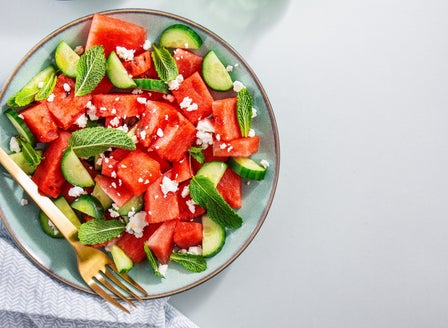Melons are an absolute summer favourite, who can resist their sweet juicy fruit on a hot summer's day. Melons picked fresh from the vine are unbelievably sweet and have a much better flavour than the ones you might find in the supermarket. The flavour and sugar content of fresh melons are positively mind-blowing, and makes growing them very rewarding.
Planting Calendar
Sow melon seeds in early spring for growing in a greenhouse or in mid-spring for outdoor crops. Once 3 or 4 true leaves (after the rounded seed leaves) have formed, you can plant out into the garden. Alternatively, seedlings are available in garden centres from late September for sowing directly.
Harvest In
80-100 days.
Melons are ready to harvest when the bottom of the fruit has turned a cream or yellow colour. Alternatively when the stem attached to the fruit shrivels and turns brown it is time to pick.
Prepare
Position
Melons need plenty of warmth and good sunlight to grow and fruit well, they must have a warm, sunny, sheltered position. Melons can also be grown in containers, the minimum size pot would be no less than 40cm.
Soil
When planted into the ground melons like a free draining soil that is rich in organic matter. To improve the organic content in your soil, break up the soil and add Kings Compost and Kings Sheep Pellets then mix together well. When growing in containers, plant into Kings Container mix. This mix contains added water storage crystals and Saturaid, two products that help maintain moisture in the soil.
Plant
When planting into the ground, gently tap the plant out of its pot. Plant seedlings 50 cm apart and don't plant too deep into the soil. Dig a hole twice the depth and width of the plants root ball. Mix Kings Compost into your existing soil at a 50/50 ratio, add Sheep Pellets and Kings General Garden Fertiliser, then mix together well. For an Organic fertiliser feed with Kings Organic Vegetable Fertiliser. Back fill the hole with this soil, so that when planted the top of the plant’s roots sit level with the surrounding ground. Firm the soil down gently and water in well with Aquaticus Organic Garden Booster. In heavier clay soils, where drainage is likely to be an issue, plant onto a raised mound and sprinkle Gypsum Clay Breaker into the bottom of the hole, this helps slowly condition the soil and will help to break down the clay. When planting into containers plant in Kings Containers mix, as this has water retention crystals in it, which will help in keeping the soil moist. Firm the soil down gently and water in well with Aquaticus Organic Garden Booster.
Care
Beginner Tip
The secret with all melons is to provide masses of heat, excellent drainage, and ample water throughout the season.
Expert Tip
Melons are pollinated by bees, plant bee-friendly plants such as lavender or borage in the same area to bring more bees for better pollination.
Frequently Asked Questions
How do I plant melon seeds?
When planting into the ground, gently tap the plant out of its pot. Plant seedlings 50 cm apart and don't plant too deep into the soil. Dig a hole twice the depth and width of the plants root ball. Mix Kings Compost into your existing soil at a 50/50 ratio, add Sheep Pellets and Kings General Garden Fertiliser, then mix together well. For an Organic fertiliser feed with Kings Organic Vegetable Fertiliser. Back fill the hole with this soil, so that when planted the top of the plant’s roots sit level with the surrounding ground. Firm the soil down gently and water in well with Aquaticus Organic Garden Booster. In heavier clay soils, where drainage is likely to be an issue, plant onto a raised mound and sprinkle Gypsum Clay Breaker into the bottom of the hole, this helps slowly condition the soil and will help to break down the clay. When planting into containers plant in Kings Containers mix, as this has water retention crystals in it, which will help in keeping the soil moist. Firm the soil down gently and water in well with Aquaticus Organic Garden Booster.
When is the best time to plant melons?
Plant melons in late spring to early summer, after the last frost, when the soil is warm and temperatures are consistently above 20°C.
How often should I water my melons?
Water melons deeply once a week, ensuring the soil remains moist but not waterlogged. Increase watering frequency during hot, dry periods.
How do I prevent diseases in melons?
Ensure proper spacing for good air circulation, water at the base to avoid wetting foliage, and rotate crops annually to reduce the risk of fungal diseases.
How do I support melon vines?
Provide support for melon vines using trellises or stakes to keep the fruit off the ground, reducing the risk of rot and pests.










